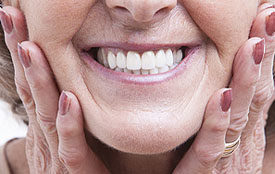Life would be harrowing if we had no ability to feel pain. Although experiencing it is unpleasant, pain's purpose is to alert us to something wrong in our body. Without pain diseases and other problems could worsen to the point of life-threatening.But pain without a purpose — the nerves simply …
The best way to prevent dental visit anxiety in your children is start those visits around their first birthday, and continue with them through childhood. Age One visits are the best way to ensure they're comfortable with the dentist now and that they'll continue the habit into adulthood.
But in spite …
Most of us are quite familiar with what traditional braces look like. But occasionally we see more complex-looking devices being worn by young orthodontic patients: thicker wires that extend outside the mouth, with straps that may go behind the neck or over the chin. What are these devices, and why …
You've seen the ads for obtaining a new tooth in one day with a dental implant. Those aren't exaggerated claims — you can leave the dental office the same day with a new tooth that looks and functions like the old one.
But the dramatic marketing aside, there is a bit …
There are an assortment of techniques and treatments in an orthodontist's toolkit, braces being the most common and best known. Of course, there wouldn't be any tools at all if teeth couldn't move naturally.
Teeth aren't directly connected to the jawbone. An elastic tissue called the periodontal ligament lies between each …
In her decades-long career, renowned actress Kathy Bates has won Golden Globes, Emmys, and many other honors. Bates began acting in her twenties, but didn't achieve national recognition until she won the best actress Oscar for Misery — when she was 42 years old! “I was told early on that because of …
So you’re tearing up the dance floor at a friend’s wedding, when all of a sudden one of your pals lands an accidental blow to your face — chipping out part of your front tooth, which lands right on the floorboards! Meanwhile, your wife (who is nine months pregnant) is …
Want to know the exact wrong way to pry open a stubborn lid? Just ask Jimmy Fallon, host of NBC-TV’s popular “Tonight Show.” When the 40-year-old funnyman had trouble opening a tube of scar tissue repair gel with his hands, he decided to try using his teeth.What happened next wasn’t …
Around ages 6 to 8, a child's primary teeth will begin to loosen to make way for their permanent teeth. If all goes well, the new set will come in straight with the upper teeth slightly overlapping the bottom.But sometimes it doesn't go that well: a child may instead develop …
When the multi-platinum recording artist, songwriter and TV personality Jason Derulo was recently asked about his ideal woman, his answer covered a remarkably broad spectrum. "There’s no specific thing," he said, "so I think it’s unfair to say what my ‘type’ is." But it turns out that there is one thing the So …
Introduce Your Family to Ours
A lifetime of good dental health starts here.
I understand the information disclosed in this form may be subject to re-disclosure and may no longer be protected by HIPAA privacy regulations and the HITECH Act.

-
Current Patient:
(860) 496-0256 -
New Patient:
(860) 421-6577
